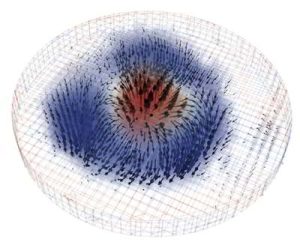Lawrence Berkeley National Laboratory Berkeley Lab Researchers Succeed in Taking 3D X-Ray Images of Skyrmion
Nanoscale spinning circles of magnetism may find broad application in microelectronic storage devices, quantum computing, and more.
This is a Press Release edited by StorageNewsletter.com on October 29, 2024 at 2:00 pmBy William Schulz, Lawrence Berkeley National Laboratory, Berkeley Lab
A difficult-to-describe nanoscale object called the magnetic skyrmion might one day yield new microelectronic devices that can do much more – for example, massive storage – all while consuming much less power.
3D reconstruction of skyrmion derived from X-ray images
(Credit: Berkeley Lab)
 But researchers need a more detailed understanding of skyrmions if they are ever to be used reliably in computational devices, including quantum computers. Peter Fischer, senior researcher, Department of Energy’s Lawrence Berkeley National Laboratory (Berkeley Lab), led a project to make 3D X-ray images of skyrmions that can characterize or measure the orientations of spins inside the whole object.
But researchers need a more detailed understanding of skyrmions if they are ever to be used reliably in computational devices, including quantum computers. Peter Fischer, senior researcher, Department of Energy’s Lawrence Berkeley National Laboratory (Berkeley Lab), led a project to make 3D X-ray images of skyrmions that can characterize or measure the orientations of spins inside the whole object.
“Our results provide a foundation for nanoscale metrology for spintronics devices,” Fischer said. The work was recently published in Science Advances. (see below)
Magnetic skyrmions can be thought of as spinning circles of magnetism, explains David Raftrey, student researcher, Fischer’s team, who was the lead author of this study. At the center, the magnetic spin is pointing upward, while moving out from the center, the magnetism twists and pulls in a downward direction. What’s more, skyrmions are stable, small, fast, and not easily unfolded, a trait materials scientists dub ‘topological.’
These spin directions are part of the appeal for skyrmions because they might be used to carry and store information in much the same way that electrons carry and store information in current devices.
“However, relying on the charge of the electron, as it is done today, comes with inevitable energy losses. Using spins, the losses will be significantly lower,” Fischer said.
But theoretical knowledge of skyrmions has been based on descriptions of them as 2D objects. In the real world of electronics and silicon wafers – no matter how thin – skyrmions have to be dealt with as 3D objects. To put skyrmions to work, or perhaps to one day synthesize custom skyrmions, researchers must be able to examine and understand their spin characteristics throughout the whole 3D object.
If you are looking at a skyrmion magnetic whirlpool from the top and start slicing off layers, you might think that each successive layer would be the same.
“But that’s not the case,” Raftrey said. “And we said, okay, how can we get our arms around this? How do we actually demonstrate this?”
He took a thin magnetic layer, which was synthesized by colleagues from Western Digital, and patterned a nanodisk using the Molecular Foundry’s nanofabrication facility. To obtain 3D tomographic images he traveled to Switzerland to use a novel imaging technique called magnetic X-ray laminography at a microscopy beamline at the Swiss Light Source.
With X-ray laminography, “You can basically reconfigure and reconstruct [the skyrmion] from these many, many images and data,” Raftrey said.
It was a process that took months, finally yielding a better understanding of skyrmion spin structures.
A full understanding of skyrmions’ 3D spin texture “opens opportunities to explore and tailor 3D topological spintronic devices with enhanced functionalities that cannot be achieved in two dimensions,” Fischer said.
The Molecular Foundry is a DOE Office of Science user facility at Berkeley Lab.
The work was supported by the DOE Office of Science.
Article: Quantifying the topology of magnetic skyrmions in three dimensions
Science Advances has published an article written by David Raftrey, Simone Finizio, Materials Sciences Division, Lawrence Berkeley National Laboratory, Berkeley, CA 94720, USA., and Physics Department, University of California Santa Cruz, Santa Cruz, CA 95064, USA, Rajesh V. Chopdekar, Western Digital Research Center, Western Digital Corporation, San Jose, CA 95119, USA, Scott Dhuey, Molecular Foundry, Lawrence Berkeley National Laboratory, Berkeley, CA 94720, USA, Temuujin Bayaraa, Materials Sciences Division, Lawrence Berkeley National Laboratory, Berkeley, CA 94720, USA, Paul Ashby, Molecular Foundry, Lawrence Berkeley National Laboratory, Berkeley, CA 94720, USA, Jörg Raabe, Swiss Light Source, Paul Scherrer Institute, 5232 Villigen PSI, Switzerland, Tiffany Santos, Western Digital Research Center, Western Digital Corporation, San Jose, CA 95119, USA, Sinéad Griffin, Materials Sciences Division, Lawrence Berkeley National Laboratory, Berkeley, CA 94720, USA, and Molecular Foundry, Lawrence Berkeley National Laboratory, Berkeley, CA 94720, USA, and Peter Fischer, Materials Sciences Division, Lawrence Berkeley National Laboratory, Berkeley, CA 94720, USA, and Physics Department, University of California Santa Cruz, Santa Cruz, CA 95064, USA.
Abstract: “Magnetic skyrmions have so far been treated as two-dimensional spin structures characterized by a topological winding number. However, in real systems with the finite thickness of the device material being larger than the magnetic exchange length, the skyrmion spin texture extends into the third dimension and cannot be assumed as homogeneous. Using soft x-ray laminography, we reconstruct with about 20-nanometer spatial (voxel) size the full three-dimensional spin texture of a skyrmion in an 800-nanometer-diameter and 95-nanometer-thin disk patterned into a 30× [iridium/cobalt/platinum] multilayered film. A quantitative analysis finds that the evolution of the radial profile of the topological skyrmion number is nonuniform across the thickness of the disk. Estimates of the micromagnetic energy densities suggest that the changes in topological profile are related to nonuniform competing energetic interactions. Our results provide a foundation for nanoscale metrology for spintronics devices using topology as a design parameter.“













 Subscribe to our free daily newsletter
Subscribe to our free daily newsletter
